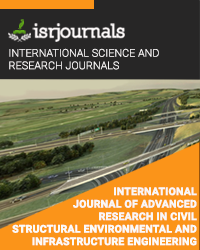analysis of fracture by using parameters in concrete abaqus software
Ganesh Naidu Gopu,
Published in International Journal of Advanced Research in Civil,Structural,Environmental and Infrastructure Engineering and Developing
ISSN: 2320-723X Impact Factor:1.7 Volume:2 Issue:3 Year: 14 February,2016 Pages:112-117

Abstract
: It is commonly accepted that there is a size effect on the nominal resistances of quasi-brittle materials such as cementitious materials. This effect must be taken into account in the design of the ultimate behavior of concrete structures in order to avoid damage and crack openings. These parameters are frequently used to study the behavior of concrete and to characterize the durability of structures. Different theories exist in the literature to describe the size effect. Among them, we find the deterministic theory of Bazant where fracture energy is considered independent of the size and it is assumed that at peak load, the crack length is proportional to the size of the specimen. In this work, attention is paid to investigate numerically, the relationship between crack openings and length, and the size of the specimens. Various fracture parameters have also been studied by validating with the existing work for a concrete of grade M35 grade of concrete based on the RILEM standards. The present study shows the determination of fracture parameters of beams size-ranging from 100-400 mm using ABAQUS. Then analyzed the size-effect behavior of various fracture parameters obtained from different sizes of the beam
Kewords
Stress intensity factor, Strain energy release rate, Crack tip opening displacement, Fracture energy.
Reference
Ahmed Loukili., Panagiotis Kotronis., Syed Yasir Alam., (2013), Crack propagation and size effect in concrete using a non-local damage model”, Engineering Fracture Mechanics, Elsevier Ltd, 109, 246-261 2. Bazant. Z.P, M.T. Kazemi., (1990), “Determination of fracture energy, process zone length and brittleness number from size effect, with application to rock and concrete” International Journal of Fracture 44: 111-131. 3. Chengsheng Ouyang., Tianxi Tang., Surendra P. Shah., (1992), “Fracture mechanics and size effect of concrete in tension”. Journal of Structural Engineering, ASCE, 118(11), 3169-3185. 4. David Fanella1., Dusan Krajcinovic., (1988), “Size effect in concrete”. Journal of Engineering Mechanics, ASCE, 114 (4), 704-715. 5. Elices.M and Planas.j, (1990), “Fracture criteria for concrete: mathematical validations and experimental validation”, Eng. Fract. Mech., 35, 87-94. 6. Gunneswara Rao.T.D, Muralidhara Rao.T., (2013), “Size effect of plain concrete beams: An experimental study”, International Journal of Research in Engineering and Technology, 2(6), 1047-1055. 7. Hanson. J.H. and Ingraffea, A.R. (2003), “Using numerical simulations to compare the fracture toughness values for concrete from the size-effect, two-parameter and fictitious crack models”, Eng. Fract. Mech., 70, 1015-1027

